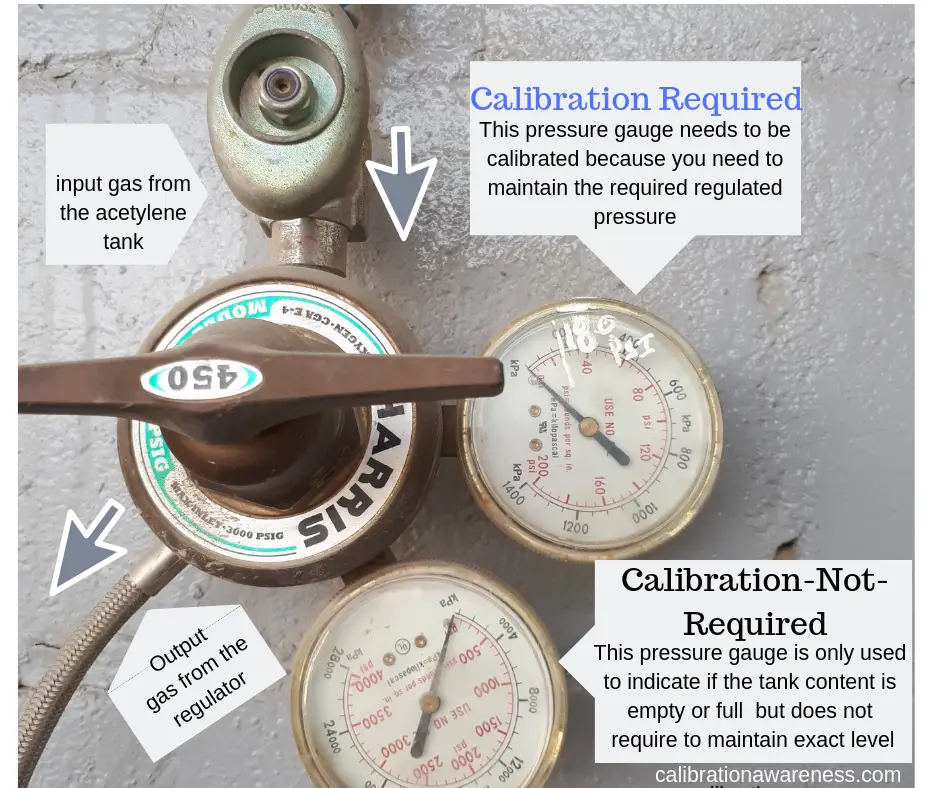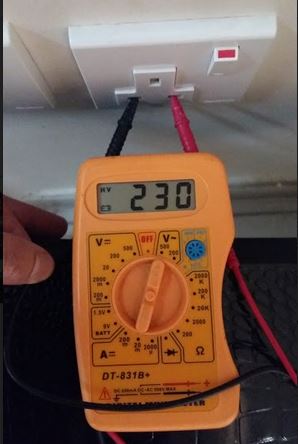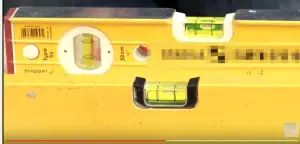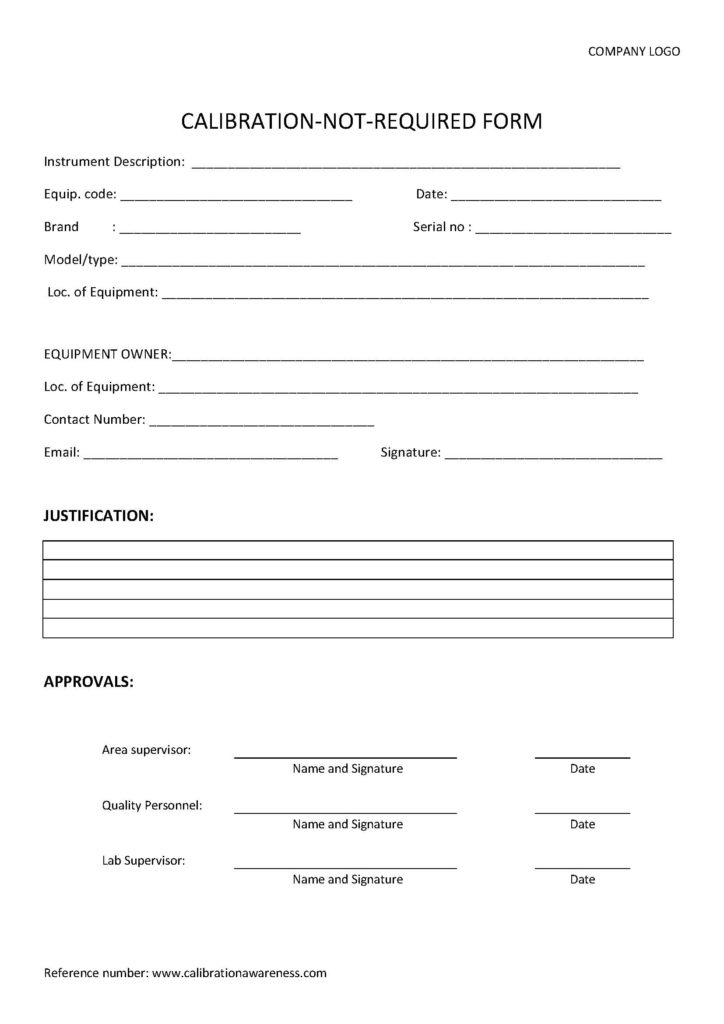Why is Calibration Not Required?
During my career as a calibration engineer in an in-house calibration laboratory, one of our goals is to provide 100% calibration to all measuring instruments that are being used inside our facility that directly or indirectly affect product quality.
But as the day passed, more and more instruments are being submitted and requested to be calibrated, so more and more instruments are now included to be registered and monitored (so our goal are targeted).
But as I observed and experienced during the visit at the site and interview with co- technicians, maintenance, and engineers, some instruments are not that critical in their usage or is not directly providing measurements, in other words, it does not need calibration.
In this blog post, in support of in-house calibration, I will share my experience on how to identify instruments that do not need calibration within your company, how to document those instruments, provide justification for implementation and the advantages (and disadvantages).
By determining those measuring instruments that do not require calibration will save us time, resources and energy. All measuring instruments that are identified will be labeled as ‘’Calibration Not Required”.

The Importance of Determining or Identifying ‘Calibration Not Required’ Instruments.
While performing calibration in our measuring instrument is the main job, we should also determine what are those instruments that do not require calibrations.
Calibration-not-required is the term we used to define a measuring instrument that does not need calibration. It is a measuring instrument but with different purpose or usage. This is sometimes called ‘for reference only‘.
Calibration-Not-Required also covers all instruments which are not included in the monitoring or recall of the internal calibration management, because the calibration is already performed by other factors, for example, by the equipment owner during preventive maintenance using another calibrated instruments or the unit itself has an auto-calibration using a traceable reference standard installed.
.
‘Calibration Not Required’ Benefits Once Implemented:
- This will give us more focus on the Measuring & Test Equipment (M&TE) that are more valid to be calibrated, meaning, we can filter out those directly in connection to the processor product produced.
- Determining what is not required to be calibrated save us time and energy (energy-related to physical and electrical or power), our load will be lessened where productivity will increase.
- The downtime of the machine shot down due to scheduled calibration will be minimized.
- Easy monitoring of M&TE that are most likely to be calibrated. It will only include the most critical instruments for calibration.
- Avoid duplication of calibration. Some instruments usually installed in machines are already calibrated indirectly once assessed properly.
- Some M&TE is not critical to the process but are blindly submitted for calibration just to avoid some problem with the auditor – you will be more confident to defend this just in case.
- Save us some resources in terms of money (of course), when utilizing a third party calibration.
Disadvantages of ‘Calibration Not Required’ Implementation
Usually, not all are happy in this procedure (especially the quality personnel). Why? Below are some reasons:
- Some confusion will be brought up where further discussions are needed to justify these procedures (which is justifiable).
- You will be challenged by your auditors to explain and justify.
- When you placed a ‘Calibration not Required’ labels in some of your instruments, this is like a shiny object where they may be questioned.
That is why doing this procedure requires a good knowledge of the operation of the process (and the M&TE itself) plus great support of the users or the people involved in order to come up with the best justifications in which I will show you later in this post.
..
What Needs Calibration?
Before we determine the Instruments that do not require calibrations, First, we will identify what needs calibration.
- All inspection, measuring, and test equipment that can affect or determine product quality. This means that if you are using the instruments to verify the acceptance of a product whether to pass or fail based on the measured value you have taken, the instrument should be calibrated.
.
- Measuring equipment which, if out of calibration, would produce unsafe products.
.
- measuring devices having specified tolerances in their usage
.
- The instrument has the capability to provide a quantitative measurement, which means that it measures a certain range with a given unit (mm, Kg, psi, etc) in comparison with a simple indicator that displays only a high or low and open or close.
.
- Equipment which requires calibration because of an agreement. An example is a customer before progressing into a contract will see to it that the equipment that will produce their product is calibrated.
.
- All measuring and testing equipment (standards) having an effect on the accuracy or validity of calibrations. These are the master standards that we used to verify other instruments or equipment for their accuracy or validity of readings.
.
- Required by auditors.
.
.
Steps In Implementing ‘Calibration Not Required’ Procedure.
- Determine the instruments to be labeled with ‘calibration not required’ status
- Provide calibration not required justification and have it approved
- Place Calibration-Not-Required Labels (or For Reference Only sticker)
- Update your records.
.
What Instruments Does Not Need Calibration? How to Identify Instruments to be Labeled as Calibration Not Required?
If there are instruments that need calibration, there are also instruments that do not need calibration.
Identification will commence once a new Instrument has been introduced or installed. This may be on-site or submitted in the internal calibration laboratory.
We will use the below guide in identifying those instruments not requiring calibration:
- The usage is not critical in your process.
- just to display a certain reading for the purpose of functionality check.
- What does ‘For reference only’ mean? In this type of condition, ‘calibration not required‘ is also known as ‘for reference only‘. Why, because you are only using the instruments not to get exact measurement results but only to get information regarding its status. See the below examples.
.- An example of this is a pressure gauge installed in a machine where the displayed pressure indicates only if there is a presence of gas or liquid.
- Another example is the pressure gauge installed in a gas tank, you only need to know that there is enough pressure to do the job. You do not need to have an exact level or pressure for the input since it is regulated at the output. Just only a visual reference to see if the tank is already empty or not.

‘calibration not required’ or ‘for reference only’ label can be assigned for the input pressure which is used only to indicate the level of the tank content (empty or full) which is not critical in the process compared to the regulated output pressure in which we need to maintain at a required level (180 psi)
.
- A Multimeter used ONLY for troubleshooting that indicates the presence of a voltage or a short and open within a line connection. But if the same meter is used for testing and measuring if there is a pass or a fail based on the measured value, the meter should be calibrated.

A multimeter that is used only to check the presence of a voltage for troubleshooting.
- The instrument functions as an indicator only, no tolerance specified in the process (for example: high or low)
.
- just to display a certain reading for the purpose of functionality check.
- Used as accessories only to support the main function of an instrument. You cannot perform a measurement without this accessory.
- Some example is a coil of wire used to amplify a current to be measured, or a hand pump used to create pressure.
.
- Some example is a coil of wire used to amplify a current to be measured, or a hand pump used to create pressure.
- Its accuracy is established by a higher or reference to a higher or more accurate calibrated instrument within a group.
- It has a check standard within the group. for example, a pressure gauges that are connected in series to a more accurate calibrated gauges where they are compared or referenced to.

Example of an indicator, you cannot quantify the measurement value - A temperature gauge that has another temperature indicator monitored in a separate location or panel.
.
- It has a check standard within the group. for example, a pressure gauges that are connected in series to a more accurate calibrated gauges where they are compared or referenced to.
- If the instrument is verified regularly or continuously monitored by a calibrated instrument that is documented in a measurement assurance process.
- For example, a room thermometer which is regularly monitored by a separately calibrated thermometer.
- Calibration is performed during preventive maintenance (no need to include in our monitoring list)
.
- The instrument is part of a system or integrated into a system where the system is calibrated as a whole.
- For example, a thermocouple that is permanently connected to the oven. The oven and thermocouple are calibrated as one, but if the same thermocouple is being used to other units, calibration of the thermocouple is needed..
All of the above guidelines can be used as a calibration not required justifications
How to Implement the Placement of ‘Calibration-Not-Required‘ Label?
In order for us to legally implement the placement of ”calibration not required” status of a certain measuring instrument, have it justify and approved by the required authorities. In this way, we are not just documenting the process but we are informing the whole team. Also, in case the auditor will question the instrument, we have some evidence to show.

Below are some steps to follow for the approval and acceptance of the implementation:
- Create a form where we can put all the details of the Instruments ( you can name it Calibration-Not-Required Form). Ensure the form is a controlled document
.
- Put the reason or justification why Calibration is not required. (choose one or more in the list above for identifying). Example: The instrument functions as an indicator only that displays a high and low reading, no tolerance specified and it does provide a quantitative measurement. The more the reason, the better the justification.
.
- Have the form approved by the equipment owner, its supervisor, QA/QC personnel, and the Internal Calibration Laboratory Head by placing their signature on the form.
.
- Once all have agreed and signed, place a ‘’Calibration-Not-Required’’ label. This should be clear and visible.
.
- Update and file your records.
.
Conclusion
I have shared with you in this post the importance of why we need to determine those instruments that do not need calibration which in turn saves us time, effort, and resources.
I have presented on how to implement this process including the advantages and disadvantages. We have seen the benefits and importance of identifying Calibration-Not-Required Instruments.
Proper documentation and good support by the related team is one key to successfully determine and close all related issues regarding this matter, furthermore, we should maintain a good relationship and communication.
Another technique that is used when saving time and resources is involved is to implement a Calibration interval analysis. Check out my post in this link: calibration interval
Do not forget to get a copy of your cheat sheet in this link: calibrationawareness.com/cheatsheet
Thank you for visiting My site, Please check my other post regarding the Elements in Implementing an Internal Calibration Lab.
Thank you for reading my post. If you like what you read, please share, subscribe and Buy Me A Coffee
Edwin
31 Responses
fraz
Any information about calibration bussines. Pls email.
omer
Hello Very nice information, congratulations.
edsponce
Hi Mr. Omer,
Thank you, Appreciate your comment.
Best Regards,
Edwin
Nguyễn Văn Thiêm
Thank you Edwin,
That is a very helpful article
edsponce
Hi Nguyen,
You are welcome. I appreciate your comment, I am glad it helped you in some way.
Thank you for reading my post.
Best regards,
Edwin
KC
Hi Edwin,
Do you have any sample approval form for “Calibration Not Required” for my reference?
edsponce
Hi KC,
I created a sample CALIBRATION NOT REQUIRED form for your reference, you may use it as it is, just a minor edit if you want.
Here is the link. >>> http://bit.ly/cal-notrequired_form
Thank you for reading my post.
Hope this helps,
Edwin
KC
Hi Edwin,
Thank you so much for your sharing.
Your post has really helped me a lot.
Thanks also for creating the sample for my reference.
Regards
KC
edsponce
Hi KC,
You are welcome. Happy to help.
Thank you also for the positive feedback and the time you spent reading my posts.
Any other concern or some recommendations, please feel free to comment.
Thanks and regards,
Edwin
KC
Hi Edwin,
Thank you for your sharing.
Just want to share that I have benefit a lot from your post.
Great write-up.
Regards
KC
edsponce
Hi KC,
Happy to help. Appreciate your positive comments.
Your comments give motivations for me to share more.
Thanks and regards,
Edwin
Jamie Stepien
Hello
Thank you for this information it is very useful. Is this all just common sense or is there a standard process for determining if calibration is required (i.e is it written down in an ISO standards)?
edsponce
Hi Mr. Jamie,
You are welcome. I appreciate the time you spend for reading my post.
Yes, you are right. It is more on common sense but with the full understanding of the requirements of the standard on what really is needed to be calibrated. This can be referred or relate to an ISO standard, let me give you below statement or clause from the Standards as an example.
As per ISO 17025:2017
Clause 6.4.6 Measuring equipment shall be calibrated when:
— the measurement accuracy or measurement uncertainty affects the validity of the reported results,
>> When the measuring instruments we used do not affect the validity of the reported results, therefore, calibration is not required.
As per ISO 9001:2015
The requirement under clause 7.1.5.1 is:
– The organization shall determine and provide the resources needed to ensure valid and reliable results when monitoring or measuring is used to verify the conformity of products and services to requirements.
>> This means that calibration is needed when measuring instruments are used to verify the conformity of products to the requirements. But in the opposite view, even if it is a measuring instrument but it is not used to verify the conformity of products to requirements, therefore, calibration is not required.
Thank you for this question which leads me to provide a more valid justification.
I hope this explains my point.
Thanks and regards,
Edwin
Purushottam kumar
If the instrument is new, is calibration required ?
Instruments like Digital micrometer, Digital vernier caliper etc ??
edsponce
HI Purushottam,
Yes, it is still required, remember that calibration will ensure that the instrument is accurate by comparing it to a reference standard. Without this comparison process in calibration, including measurement uncertainty results, you will not be sure if your instrument is accurate even if it is still new.
And as evidence of calibration that shows how accurate your instrument is, is by having the calibration certificate with it.
Thanks and regards,
Edwin
Félix
Hi Edwin,
Nice article. Question, how do you keep and maintain the traceability of the CNR instruments? Do you assign a system number or just a label of CNR? what are the bet practices in the medical devices industry?
My apologies for so many questions
Regards
edsponce
Hi Felix,
Traceability is maintained through the placement of just a label and a record in the masterlist. This depends on the design or setup of the internal lab and the person involved, you can put a system number if you want to.
In the past company I work for, there are 2 ways where this is documented. The first is in the user or process area owner where he has a monitoring sheet of all the instruments under his care. Second is the calibration lab where we have a master list of all the instruments involved, including the filing of the accomplished CNR form.
There are no special rules or requirements so you are free to use any methods as long as you can identify properly and effectively considering the guidelines I have mentioned.
I do not have experience in the medical industry but I believe the principle is the same as long as proper assessment and approval are employed in the process. You may check your standards if specific requirements are mentioned but if there is none, you can develop your own procedure and implement it. This is also a good tool to assess all the related instruments and equipment in your company.
I hope this helps, thank you for reading my post.
Edwin
Rose Gaffar
Great stuff Edwin
Is it possible to write out a few typical questions that auditors would ask during an audit?
edsponce
Hi Rose,
I have written a post about your query. It is not directly an audit question during accreditation but I believe it has the same principle and applicability. Please check out this link >> Audit Questions
Thanks and regards,
Edwin
Maizatul Adlina
I purchased new caliper do i need to perform calibration on it prior use?
edsponce
Hi Maizatul,
As per the requirements of the standards (ISO 9001 or ISO 17025) that all instruments that has an effect to the quality of products (plus other reasons that I shared above) shall be calibrated before use. if this is your case, then yes you should have it calibrated prior to use.
If you use only the caliper just to check dimensions for visual reference without any tolerances set or if it is not used to determine a pass or failed results, then there is no need to calibrate it.
I hope this helps,
Edwin.
m saiful
where is the article that says it pack in ISO 9001? please can share too, thank you
edsponce
Hi M Saiful,
Sorry, but there is no article about ISO 9001 that tells about Calibration-not-required, what I am referring to is the opposite meaning of the clause in ISO 9001 requirements (see Clause 7.1.5.2) for an instrument subject for calibration.
Any instrument that is used to verify the conformity of products or needs confidence that the instrument is providing a valid results, then it should be calibrated. Get the opposite view of these requirements then you will have your basis for a calibration-not-required implementation.
I hope I answered your concern,
Edwin
m saiful
Okay, thank you Mr Edwin
edsponce
You are welcome. Thanks for visiting my site.
SAURABH NEGI
Dear Sir,
thanks you so much for such a informative blog.
please guide me calibration required or not required for following Non Destructive testing equipments
1: Ultrasonic Flaw detector
2: Probes of Flaw detector
3: Standard Ultrasonic testing block V1 and V2 and other DSC Blocks
4: Pie gauges in Magnetic Partical inspection
5: Magnetic Strips
6: liquid Penetrating standard test aluminum test blocks
regards
Saurabh
edsponce
Hi Saurabh,
You are welcome.
I cannot answer your concerns directly, there are parameters that you need to consider before you can decide.
I have a checklist that you can download that can guide you, you may download it in this link >> checklist
I hope this helps,
Edwin
E. Tol
Dear Sir,
Very informative blog.
I am from printer manufacturing company.
I would like to ask if those equipment (e.g. caliper, micrometer) used in fabrication of metal jigs still need to be calibrated?
Or I need to identify if jig’s purpose are critical or not?
Thank you very much.
edsponce
Hi E.Tol,
Since you are using it to manufacture jigs, Yes, it is important that it is calibrated. But one way to know if it needs calibration is that, if the equipment is used to determine a pass or failed decision, then it needs to be calibrated.
Thanks and regards,
Edwin
Tommy
I have a question regarding the calibration cheatsheet.
Should we answer ALL questions? Let’s take for example the question 1.
You have question 1, 1a, 1b.
To us, 1a and 1b kind of repeat the same spirit of question 1. We would answer only 1A and 1B and not 1.
In your opinion, is it okay to do it that way?
edsponce
Hi Tommy,
YEs it is ok, you can just answer #1. Question 1a and 1b is a more specific question to guide you further.
I hope this helps,
Edwin